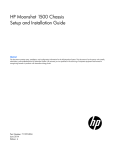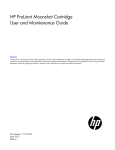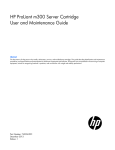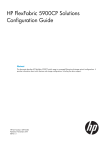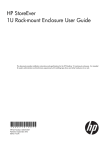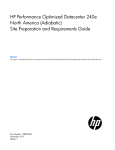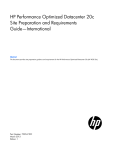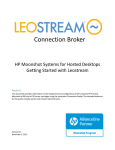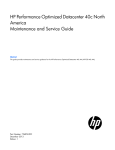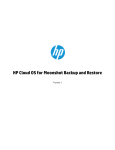Download HP Moonshot-45XGc User's Manual
Transcript
HP Moonshot-45XGc Switch
User and Maintenance Guide
Abstract
This document is for the person who installs, administers, services, and troubleshoots switches. This guide provides identification, setup, installation,
and removal procedures. HP assumes you are qualified in these areas.
Part Number: 796044-001
September 2014
Edition: 1
© Copyright 2014 Hewlett-Packard Development Company, L.P.
The information contained herein is subject to change without notice. The only warranties for HP products and services are set forth in the express
warranty statements accompanying such products and services. Nothing herein should be construed as constituting an additional warranty. HP shall
not be liable for technical or editorial errors or omissions contained herein.
Contents
Component and LED identification .................................................................................................. 5
Chassis front panel LEDs and buttons.............................................................................................................. 5
Moonshot-4QSFP uplink module components .................................................................................................. 6
Moonshot-4QSFP uplink module buttons and LEDs ........................................................................................... 7
Moonshot switch module LEDs ....................................................................................................................... 8
Operations................................................................................................................................... 9
Extend the chassis from the rack .................................................................................................................... 9
Remove the access panel ............................................................................................................................ 10
Open the cable management arm ................................................................................................................ 11
Remove the uplink module blank .................................................................................................................. 12
Remove the switch module blank ................................................................................................................. 12
Setup......................................................................................................................................... 13
Installation information and guidelines.......................................................................................................... 13
Uplink module bays .................................................................................................................................... 14
Installing the uplink module ......................................................................................................................... 14
Installing the switch module ......................................................................................................................... 15
Cabling ..................................................................................................................................... 18
Supported cables and transceivers ............................................................................................................... 18
Installing a DAC cable ................................................................................................................................ 18
Installing a transceiver ................................................................................................................................ 19
Command Line Interface .............................................................................................................. 21
Connecting to the switch console ................................................................................................................. 21
Default user name and password ....................................................................................................... 21
Terminal settings .............................................................................................................................. 21
Accessing the CLI locally ................................................................................................................... 21
Accessing the CLI remotely ................................................................................................................ 22
Accessing the CLI using iLO............................................................................................................... 22
Configuration ............................................................................................................................. 24
Switch documentation ................................................................................................................................. 24
Firmware ................................................................................................................................... 25
Update the switch firmware ......................................................................................................................... 25
Updating switch firmware with a reboot ....................................................................................................... 25
Network mapping....................................................................................................................... 26
Production network mapping ....................................................................................................................... 26
Management network mapping ................................................................................................................... 27
Interfaces .................................................................................................................................................. 27
Moonshot-4QSFP+ uplink interfaces ................................................................................................... 28
Moonshot-45XGc downlink interfaces ................................................................................................ 29
Troubleshooting .......................................................................................................................... 30
Troubleshooting resources ........................................................................................................................... 30
Illustrated parts catalog ............................................................................................................... 31
Contents
3
Customer self repair ................................................................................................................................... 31
Parts only warranty service .......................................................................................................................... 31
Switch customer self repair components ........................................................................................................ 32
Removal and replacement procedures ........................................................................................... 33
Removing the switch module........................................................................................................................ 33
Removing the uplink module ........................................................................................................................ 33
Regulatory information ................................................................................................................ 35
Safety and regulatory compliance ................................................................................................................ 35
Turkey RoHS material content declaration ..................................................................................................... 35
Ukraine RoHS material content declaration ................................................................................................... 35
Warranty information ................................................................................................................................. 35
Electrostatic discharge ................................................................................................................. 36
Preventing electrostatic discharge ................................................................................................................ 36
Grounding methods to prevent electrostatic discharge .................................................................................... 36
Specifications ............................................................................................................................. 37
Chassis environmental specifications ............................................................................................................ 37
Chassis specifications ................................................................................................................................. 37
Support and other resources ........................................................................................................ 38
Before you contact HP ................................................................................................................................ 38
HP contact information ................................................................................................................................ 38
Acronyms and abbreviations ........................................................................................................ 39
Documentation feedback ............................................................................................................. 41
Index ......................................................................................................................................... 42
Contents
4
Component and LED identification
Chassis front panel LEDs and buttons
Item
Description
LED Status
1
Chassis power LED
Flashing green = The chassis is waiting to power on.
Green = Normal operation
Amber = Standby operation
Off = No power
2
Chassis health LED
Green = Normal operation
Flashing amber = Degraded condition
Flashing red = Critical condition
Off = No power
3
Chassis UID LED/button
Blue = Chassis ID is selected.
Flashing blue = System firmware update is in process.
Off = Chassis ID is not selected.
4
Cartridge health LEDs
Green = Normal operation
Amber = Standby mode
Flashing amber = Degraded condition
Flashing amber (All) = Moonshot 1500 CM module is not installed.
Flashing red = Critical condition
Off = Cartridge is not installed or no power exists.
5
Switch module A health
LED
Green = Normal operation
Flashing amber = Degraded condition
Flashing red = Critical condition
Off = Switch module is not installed or no power exists.
6
Switch module B health
LED
Green = Normal operation
Flashing amber = Degraded condition
Flashing red = Critical condition
Off = Switch module is not installed or no power exists.
Component and LED identification
5
Moonshot-4QSFP uplink module components
Item
Component
Description
1
Serial console port
For management
2
QSFP+ ports Q1–Q4
40Gb Ethernet*
*Ports Q1–Q4 support Ethernet traffic only.
The following cables and transceiver modules are supported:
•
HP 40GBASE QSFP+ DAC
•
HP 40GBASE QSFP+ to 4x10G SFP+
•
HP 40GBASE QSFP+ SR4
•
HP 40GBASE QSFP+
•
HP QSFP+ to SFP+ Adapter
Use any available port to connect to the data center. Be sure the port is populated with a supported HP
transceiver module that is compatible with the data center switch port type.
Component and LED identification
6
Moonshot-4QSFP uplink module buttons and LEDs
Item
Description
Status
1
Uplink module UID
LED/button
Solid blue = Switch module ID is selected.
Flashing blue = Switch module firmware
update is in progress.
Off = Switch module ID is not selected.
2
Uplink module health Green = Normal operation
LED
Flashing amber = Degraded condition
Flashing red = Critical condition
Off = No power
3
Uplink module link
LED
Solid green = Link
Off = No link
4
Uplink module
activity LED
Flashing green = Activity
Off = No activity
5
Reset button
Resets the switch module
Component and LED identification
7
Moonshot switch module LEDs
Item
Description
Status
1
Switch module power Green = Normal operation
LED
Amber = Standby operation
Off = No power
2
Switch module health Green = Normal operation
LED
Flashing amber = Degraded condition
Flashing red = Critical condition
Off = No power
3
Switch module uplink Green = Link
activity LED
Flashing green = Activity
Off = No activity
4
Switch module
Green = Link
downlink activity LED Flashing green = Activity
Off = No activity
5
Switch module UID
LED/button
Solid blue = Switch module ID is selected.
Flashing blue = Switch module firmware
update is in progress.
Off = Switch module ID is not selected.
6
Access panel sensor
Detects the presence of the access panel*
*The fan speed adjusts automatically when the access panel is installed or removed.
Component and LED identification
8
Operations
Extend the chassis from the rack
1.
Pull down the quick release levers on each side of the chassis.
WARNING: To reduce the risk of personal injury or equipment damage, be sure that the rack is
adequately stabilized before extending a component from the rack.
2.
Extend the chassis from the rack until it locks once.
3.
Press the push tab on the rail, and then fully extend the chassis.
WARNING: To reduce the risk of personal injury, be careful when pressing the server rail-release
latches and sliding the server into the rack. The sliding rails could pinch your fingers.
Operations
9
4.
After performing the installation or maintenance procedure, slide the chassis back into the rack, and
then press the chassis firmly into the rack to secure it in place.
Remove the access panel
IMPORTANT: After performing a procedure inside the chassis, always install the access panel on
the chassis when complete. Do not operate the chassis for long periods of time with the access
panel removed.
IMPORTANT: To maintain appropriate cooling, fans will operate at a high speed when the
access panel is removed.
IMPORTANT: When the access panel is removed, the chassis might be placed into a low power
operating state to reduce thermal stress.
To remove the component:
1.
If the locking latch is locked, use a T-15 Torx screwdriver to unlock the latch.
2.
Open the locking latch.
The access panel slides back, releasing it from the chassis.
Operations
10
3.
Lift and remove the access panel.
Turn the access panel over to locate the HP Moonshot 1500 Chassis label. This label provides information on
LED status indicators, component identification, and chassis and switch installation procedures.
Open the cable management arm
To open the cable management arm, lift it up as you swing it open.
Operations
11
Remove the uplink module blank
Remove the component as indicated.
Remove the switch module blank
Remove the component as indicated.
Operations
12
Setup
Installation information and guidelines
Before installing the module, review the following:
•
Always install the switch module and the uplink module in corresponding bays. Both components must
be installed for normal operation.
•
The switch module and the uplink module can be installed in any order.
•
The switch module and the uplink module power down when either module is removed from the chassis.
•
The switch module and the uplink module power up after both modules are installed in the chassis.
•
Removing any component from bay A or bay B does not disrupt traffic for the other switch.
•
Always use the recommended firmware version. For current information on recommended firmware
versions, see the HP website (http://www.hp.com/go/moonshot/download).
•
For the most current product information, see the HP Moonshot Information Library
(http://www.hp.com/go/moonshot/docs).
Setup 13
Uplink module bays
The uplink module can be installed in the uplink module bays located in the rear of the chassis.
Installing the uplink module
IMPORTANT: To avoid connectivity loss, do not remove any network cables or uplink modules
already in operation.
1.
Remove the uplink module bay blank.
Setup 14
2.
Prepare the uplink module for installation.
3.
Install the uplink module.
4.
Do one of the following:
o
If the switch module is already installed, verify the uplink module powers on and the health LED is
green.
o
If the switch module is not installed, install the switch module before verifying LEDs.
For more information, see the "Installation information and guidelines (on page 13)."
5.
After both components have been installed, verify the switch firmware is at the recommended firmware
version. For more information, see the HP website (http://www.hp.com/go/moonshot/download).
The installation is complete.
Installing the switch module
CAUTION: To avoid connectivity loss, do not remove switches already in operation.
To install the switch module:
1.
Extend the chassis from the rack (on page 9).
2.
Remove the access panel (on page 10).
Setup 15
3.
Locate the switch module slot and remove the blank.
4.
Prepare the switch module for installation.
Setup 16
5.
Align and install the switch module into the chassis.
6.
Do one of the following:
o
If the uplink module is already installed, verify the switch module powers on and the health LED is
green.
o
If the uplink module is not installed, install the uplink module before verifying LEDs.
For more information, see "Installation information and guidelines (on page 13)."
7.
Install the access panel.
8.
Install the chassis in the rack.
9.
After both components have been installed, verify the switch firmware is at the recommended firmware
version (http://www.hp.com/go/moonshot/download).
The installation is complete.
Setup 17
Cabling
Supported cables and transceivers
The following cables and transceiver modules are supported for the HP Moonshot-4QSFP+ Uplink Module:
•
HP 40GBASE QSFP+ DAC
•
HP 40GBASE QSFP+ to 4x10G SFP+
•
HP 40GBASE QSFP+ SR4
•
HP 40GBASE QSFP+
•
HP QSFP+ to SFP+ Adapter
Installing a DAC cable
1.
If needed, remove the packaging and protective caps.
2.
Verify the cable is the correct type by checking the label on the transceiver.
3.
Remove the dust plug from the correct port.
4.
Align the transceiver in front of the port with the label facing up.
5.
Install the cable. (A QSFP+ DAC cable shown.)
Cabling
18
Installing a transceiver
WARNING: To avoid serious injury, never look directly into an open transceiver port.
CAUTION: Disconnect all cables before removing or installing any transceivers or transceiver
adapters. Leaving the cable connected while handling the transceiver may damage the cable, the
cable connector, or the optical interfaces in the transceiver.
Do not remove and install transceivers more often than is necessary. Doing so can shorten the
useful life of the transceiver.
CAUTION: Do not remove the dust plugs from the transceiver or the connector until you are ready
to connect the cable. The plugs protect the ports and connectors from contamination and ambient
light.
NOTE: Transceivers may have a bail clasp latch or a pull tab latch. If installing a transceiver with
a bail clasp latch, be sure the latch is closed before connecting the cable.
To install a transceiver or transceiver adapter:
IMPORTANT: Use only HP approved transceivers.
1.
Verify the transceiver type by checking the label.
2.
Remove the dust plug from the correct port.
3.
Align the transceiver in front of the port with the label facing up.
4.
Install the transceiver:
o
QSFP+
Cabling
19
o
Transceiver adapter
If a cable needs to be connected, remove any dust plugs or covers, and then connect the cable.
Cabling
20
Command Line Interface
Connecting to the switch console
To connect to the switch console, use one of the following methods:
•
To connect locally, use the serial console port ("Accessing the CLI locally" on page 21).
•
To connect remotely, be sure the management network is connected to the iLO CM management port
("Accessing the CLI remotely" on page 22).
•
To connect using iLO, use the virtual serial port from the iLO CLI ("Accessing the CLI using iLO" on page
22).
Default user name and password
No user name or password is required to login to the switch by default.
Terminal settings
Use the following terminal settings when connecting to the serial console port ("Moonshot-4QSFP uplink
module components" on page 6):
•
115200 baud rate
•
8 data bits
•
No parity
•
1 stop bit
•
No flow control
Accessing the CLI locally
If using a PC with a terminal emulator, be sure a terminal emulator is installed before communicating with the
switch.
1.
Use a console cable to connect a PC or terminal to the serial console port on the uplink module.
("Moonshot-4QSFP uplink module components" on page 6)
2.
Configure the terminal settings (on page 21).
3.
Start the terminal.
The switch prompt appears.
Command Line Interface
21
Accessing the CLI remotely
Remote administration of the switch occurs through the iLO/MGMT port, located on the iLO CM module. To
communicate with the switch remotely, connect the iLO CM management port to the management network.
After connecting the iLO/MGMT port to the management network, perform the following:
•
Configure a static management IP address or use DHCP services to assign a management IP address.
•
Configure access authentication methods.
To see configuration procedures, see the HP Moonshot-45XGc Switch Fundamentals Configuration Guide in
the HP Moonshot Switch Library (http://www.hp.com/go/moonshot/XGcSwitch).
Accessing the CLI using iLO
To connect to the switch VSP from the iLO CLI, enter:
connect switch vsp {sa|sb}
The switch console is displayed.
Interacting with the switch from the iLO CM firmware
Interact with the switch using the following iLO CM firmware commands.
To show switch information:
o
o
o
o
o
show switch info
show switch list
show switch sn {sa|sb|sa-b}
show switch pid {sa|sb|sa-b}
show firmware revisions
Command Line Interface
22
o
o
show switch power
show switch temperature
To set switch power or switch UID LED:
o
o
set switch power {off|on} {sa|sb|sa-b}
set switch uid {off|on} {sa|sb|sa-b}
For more information on the iLO CM firmware, see the latest HP Moonshot iLO Chassis Management CLI User
Guide in the HP Moonshot Information Library (http://www.hp.com/go/moonshot/docs).
Command Line Interface
23
Configuration
Switch documentation
To configure the switch, see the switch configuration guides in the HP Moonshot Switch Information Library
(http://www.hp.com/go/moonshot/XGcSwitch).
Configuration
24
Firmware
Update the switch firmware
Before updating switch firmware, see the "Upgrading software" section of the HP Moonshot-45XGc
Fundamentals Configuration Guide in the HP Moonshot Switch Information Library
(http://www.hp.com/go/moonshot/XGcSwitch).
You can download firmware updates from the HP Moonshot Component Pack download site
(http://www.hp.com/go/moonshot/download).
IMPORTANT: Use the switch console to update firmware. The switch firmware cannot be
updated through the iLO CLI.
Updating switch firmware with a reboot
The following example upgrades a software image for an IRF fabric using the filename startup-a2105.ipe.
# Configure IP addresses and routes so the device and the TFTP server can
reach each other.
(Details not shown.)
# Configure TFTP settings on both the device and the TFTP server.
(Details not shown.)
# Display information about the current software images.
<Sysname> display version
# Use TFTP to download the image file startup-a2105.ipe from the TFTP server
to the root directory of the
flash on the master device.
<Sysname> tftp 2.2.2.2 get startup-a2105.ipe
# Specify startup-a2105.ipe as the main startup image file for all IRF member
devices.
<Sysname> boot-loader file flash:/startup-a2105.ipe slot 1 main
# Verify the startup image settings.
<Sysname> display boot-loader
# Reboot the device to complete the upgrade.
<Sysname> reboot
# Verify that the device is running the correct software.
<Sysname> display version
Firmware
25
Network mapping
Production network mapping
The first network interface discovered by the operating system routes traffic through switch A. The second
network interface discovered by the operating system routes traffic through switch B.
Network mapping
26
Management network mapping
All traffic from the service port management interface is routed through the iLO CM management port.
Interfaces
Interfaces are identified by the switch CLI using a unit/slot/port naming convention:
•
The unit number identifies the stack member within a stack of switches.
•
The slot number identifies one of the following:
•
o
Internal ports are located on slot 0.
o
External ports are located on slot 1.
The port identifies the specific physical port or logical interface being managed on a given slot.
To learn more, see switch documentation in the HP Moonshot Networking Library
(http://www.hp.com/go/moonshot/networking).
Network mapping
27
Moonshot-4QSFP+ uplink interfaces
Item
Port
Port speed
Interface
1
Q1
40Gb
10Gb
fortygige1/1/1
ten-gigabitethernet1/1/1:1–4
2
Q2
40Gb
10Gb
fortygige1/1/2
ten-gigabitethernet1/1/2:1–4
3
Q3
40Gb
10Gb
fortygige1/1/3
ten-gigabitethernet1/1/3:1–4
4
Q4
40Gb
10Gb
fortygige1/1/4
ten-gigabitethernet1/1/4:1–4
Network mapping
28
Moonshot-45XGc downlink interfaces
Interfaces 1/0/1–1/0/45 are the downlinks to the cartridge nodes.
Each SoC is identified as a cartridge node. The iLO CM firmware identifies each node as cxny, where c is
the cartridge and n is the node.
Switch interfaces correspond to cartridge nodes, respectively. For example, c28n1 corresponds to cartridge
28, node 1, and interface 1/0/28.
Network mapping
29
Troubleshooting
Troubleshooting resources
The HP Moonshot System Troubleshooting Guide provides procedures for resolving common problems and
comprehensive courses of action for fault isolation and identification, issue resolution, and software
maintenance on the HP Moonshot System. The document is available in the HP Moonshot Information Library
(http://www.hp.com/go/moonshot/docs).
Troubleshooting
30
Illustrated parts catalog
Customer self repair
HP products are designed with many Customer Self Repair (CSR) parts to minimize repair time and allow for
greater flexibility in performing defective parts replacement. If during the diagnosis period HP (or HP service
providers or service partners) identifies that the repair can be accomplished by the use of a CSR part, HP will
ship that part directly to you for replacement. There are two categories of CSR parts:
•
Mandatory—Parts for which customer self repair is mandatory. If you request HP to replace these parts,
you will be charged for the travel and labor costs of this service.
•
Optional—Parts for which customer self repair is optional. These parts are also designed for customer
self repair. If, however, you require that HP replace them for you, there may or may not be additional
charges, depending on the type of warranty service designated for your product.
NOTE: Some HP parts are not designed for customer self repair. In order to satisfy the customer warranty,
HP requires that an authorized service provider replace the part. These parts are identified as "No" in the
Illustrated Parts Catalog.
Based on availability and where geography permits, CSR parts will be shipped for next business day
delivery. Same day or four-hour delivery may be offered at an additional charge where geography permits.
If assistance is required, you can call the HP Technical Support Center and a technician will help you over the
telephone. HP specifies in the materials shipped with a replacement CSR part whether a defective part must
be returned to HP. In cases where it is required to return the defective part to HP, you must ship the defective
part back to HP within a defined period of time, normally five (5) business days. The defective part must be
returned with the associated documentation in the provided shipping material. Failure to return the defective
part may result in HP billing you for the replacement. With a customer self repair, HP will pay all shipping
and part return costs and determine the courier/carrier to be used.
For more information about HP's Customer Self Repair program, contact your local service provider. For the
North American program, refer to the HP website (http://www.hp.com/go/selfrepair).
Parts only warranty service
Your HP Limited Warranty may include a parts only warranty service. Under the terms of parts only warranty
service, HP will provide replacement parts free of charge.
For parts only warranty service, CSR part replacement is mandatory. If you request HP to replace these parts,
you will be charged for the travel and labor costs of this service.
Illustrated parts catalog
31
Switch customer self repair components
Item
Description
Spare part number
Customer self repair (on
page 31)
1
HP Moonshot-45XGc Switch Module
712695-001
Mandatory1
2
HP Moonshot-4QSFP+ Uplink Module
712694-001
Mandatory1
3
Switch module bay blank*
726173-001
Mandatory1
4
Uplink module bay blank*
745288-001
Mandatory1
* Not shown
1
Mandatory—Parts for which customer self repair is mandatory. If you request HP to replace these parts, you will be
charged for the travel and labor costs of this service.
2
Optional—Parts for which customer self repair is optional. These parts are also designed for customer self repair. If,
however, you require that HP replace them for you, there may or may not be additional charges, depending on the type
of warranty service designated for your product.
3
No—Some HP parts are not designed for customer self repair. In order to satisfy the customer warranty, HP requires that
an authorized service provider replace the part. These parts are identified as "No" in the Illustrated Parts Catalog.
Illustrated parts catalog
32
Removal and replacement procedures
Removing the switch module
CAUTION: Be sure to save the running-configuration of the switch before removing any switch
components.
CAUTION: To avoid connectivity loss, do not remove switches already in operation.
CAUTION: For proper cooling, be sure every switch module bay and uplink module bay has either
a blank or a module installed.
To remove the switch module:
1.
Extend the chassis from the rack (on page 9).
2.
Remove the access panel (on page 10).
3.
Locate and remove the switch module.
Removing the uplink module
CAUTION: Be sure to save the running-configuration of the switch before removing any switch
components.
CAUTION: To avoid connectivity loss, do not remove switches already in operation.
Removal and replacement procedures
33
CAUTION: For proper cooling, be sure every switch module bay and uplink module bay has either
a blank or a module installed.
1.
Open the cable management arm (on page 11).
2.
Remove the component as indicated.
Removal and replacement procedures
34
Regulatory information
Safety and regulatory compliance
For safety, environmental, and regulatory information, see Safety and Compliance Information for Server,
Storage, Power, Networking, and Rack Products, available at the HP website
(http://www.hp.com/support/Safety-Compliance-EnterpriseProducts).
Turkey RoHS material content declaration
Ukraine RoHS material content declaration
Warranty information
HP ProLiant and X86 Servers and Options (http://www.hp.com/support/ProLiantServers-Warranties)
HP Enterprise Servers (http://www.hp.com/support/EnterpriseServers-Warranties)
HP Storage Products (http://www.hp.com/support/Storage-Warranties)
HP Networking Products (http://www.hp.com/support/Networking-Warranties)
Regulatory information
35
Electrostatic discharge
Preventing electrostatic discharge
To prevent damaging the system, be aware of the precautions you need to follow when setting up the system
or handling parts. A discharge of static electricity from a finger or other conductor may damage system
boards or other static-sensitive devices. This type of damage may reduce the life expectancy of the device.
To prevent electrostatic damage:
•
Avoid hand contact by transporting and storing products in static-safe containers.
•
Keep electrostatic-sensitive parts in their containers until they arrive at static-free workstations.
•
Place parts on a grounded surface before removing them from their containers.
•
Avoid touching pins, leads, or circuitry.
•
Always be properly grounded when touching a static-sensitive component or assembly.
Grounding methods to prevent electrostatic discharge
Several methods are used for grounding. Use one or more of the following methods when handling or
installing electrostatic-sensitive parts:
•
Use a wrist strap connected by a ground cord to a grounded workstation or computer chassis. Wrist
straps are flexible straps with a minimum of 1 megohm ±10 percent resistance in the ground cords. To
provide proper ground, wear the strap snug against the skin.
•
Use heel straps, toe straps, or boot straps at standing workstations. Wear the straps on both feet when
standing on conductive floors or dissipating floor mats.
•
Use conductive field service tools.
•
Use a portable field service kit with a folding static-dissipating work mat.
If you do not have any of the suggested equipment for proper grounding, have an authorized reseller install
the part.
For more information on static electricity or assistance with product installation, contact an authorized
reseller.
Electrostatic discharge
36
Specifications
Chassis environmental specifications
Specification
Value
Temperature range*
—
Operating
10°C to 35°C (50°F to 95°F)
Non-operating
-30°C to 60°C (-22°F to
140°F)
Maximum Wet bulb temperature
—
Operating
28ºC (82.4ºF)
Non-operating
38.7ºC (101.7ºF)
Relative humidity (non-condensing)** —
Operating
10% to 90%
Non-operating
5% to 95%
* All temperature ratings shown are for sea level. An altitude derating of 1°C per 304.8 m (1.8°F per 1000 ft) to 3048
m (10,000 ft) is applicable. No direct sunlight allowed. Upper operating limit is 3,048 m (10,000 ft) or 70 kPa/10.1
psia. Upper non-operating limit is 9,144 m (30,000 ft).
** Storage maximum humidity of 95% is based on a maximum temperature of 45°C (113°F). Altitude maximum for
storage corresponds to a pressure minimum of 70 kPa (10.1 psia).
Chassis specifications
Specification
Value
Height
18.96 cm (7.46 in)
Depth
84.91 cm (33.43 in)
Width
44.33 cm (17.45 in)
Weight, fully loaded
81.65 kg (180.00 lb)
Weight, empty
43.09 kg (95.00 lb)
Specifications
37
Support and other resources
Before you contact HP
Be sure to have the following information available before you call HP:
•
Technical support registration number (if applicable)
•
Product name
•
Chassis serial number
•
Product identification number
•
Applicable error messages
•
Operating system type and revision level
To obtain product information, log in to iLO CM firmware and use the Show Chassis Info command. For
more information, see the HP Moonshot iLO Chassis Management CLI User Guide in the HP Moonshot
Information Library (http://www.hp.com/go/moonshot/docs).
HP contact information
For United States and worldwide contact information, see the Contact HP website
(http://www.hp.com/go/assistance).
In the United States:
•
To contact HP by phone, call 1-800-334-5144. For continuous quality improvement, calls may be
recorded or monitored.
•
If you have purchased a Care Pack (service upgrade), see the Support & Drivers website
(http://www8.hp.com/us/en/support-drivers.html). If the problem cannot be resolved at the website,
call 1-800-633-3600. For more information about Care Packs, see the HP website
(http://pro-aq-sama.houston.hp.com/services/cache/10950-0-0-225-121.html).
Support and other resources
38
Acronyms and abbreviations
CM
chassis management
CMU
HP Insight Cluster Management Utility
CSR
Customer Self Repair
DAC
direct attach cable
DHCP
Dynamic Host Configuration Protocol
ESD
electrostatic discharge
ID
identification
MAC
Media Access Control
QSFP
quad small form-factor pluggable
QSFP+
enhanced quad small form-factor pluggable
SCP
Secure Copy Protocol
SFP+
enhanced small form-factor pluggable
Acronyms and abbreviations
39
SFTP
Secure File Transfer Protocol
SoC
system on chip
SR
short range
SSH
Secure Shell
TFTP
Trivial File Transfer Protocol
UID
unit identification
VSP
virtual serial port
Acronyms and abbreviations
40
Documentation feedback
HP is committed to providing documentation that meets your needs. To help us improve the documentation,
send any errors, suggestions, or comments to Documentation Feedback (mailto:[email protected]).
Include the document title and part number, version number, or the URL when submitting your feedback.
Documentation feedback 41
Index
A
H
access panel 10
activity LED 5
administration 24
authorized reseller 38
health LED 5
HP contact information 38
HP technical support 38
B
before you contact HP 38
blank, removal 12
C
cable management arm 11
chassis, extend from rack 9
CLI (Command Line Interface) 21
compliance 35
components 5, 31
components, identification 5, 31
configuration 24
contact information 38
contacting HP 38
customer self repair (CSR) 31, 38
D
default interfaces 27, 28, 29
documentation feedback 41
downloading files 25, 38
E
electrostatic discharge 36
extending chassis from rack 9
F
firmware 25
front panel components 5
G
guidelines, installation 13
guidelines, troubleshooting 30
I
illustrated parts catalog 31
installation 14, 15
installing modules 14, 15
interface 27, 28, 29
L
LED, health 5
LEDs 5
LEDs, front panel 5
LEDs, unit identification (UID) 5
P
part numbers 31, 35
port identification 27
port mapping 26, 27
preparation procedures 9
problem diagnosis 30
R
regulatory compliance identification numbers 35
regulatory compliance notices 35
replacing a module 33
resources 30, 38
S
series number 35
setup 13
spare part numbers 31
static electricity 36
support and other resources 38
switch module bay numbering 13, 14
switch module, installing 14, 15
Index 42
T
technical support 38
troubleshooting 30
U
updating firmware 25
uplink module 14
uplink module bay identification 13, 14
uplink module, installing 14
uplink module, removing 33
W
warranty 31, 35
website, HP 38
Index 43












































